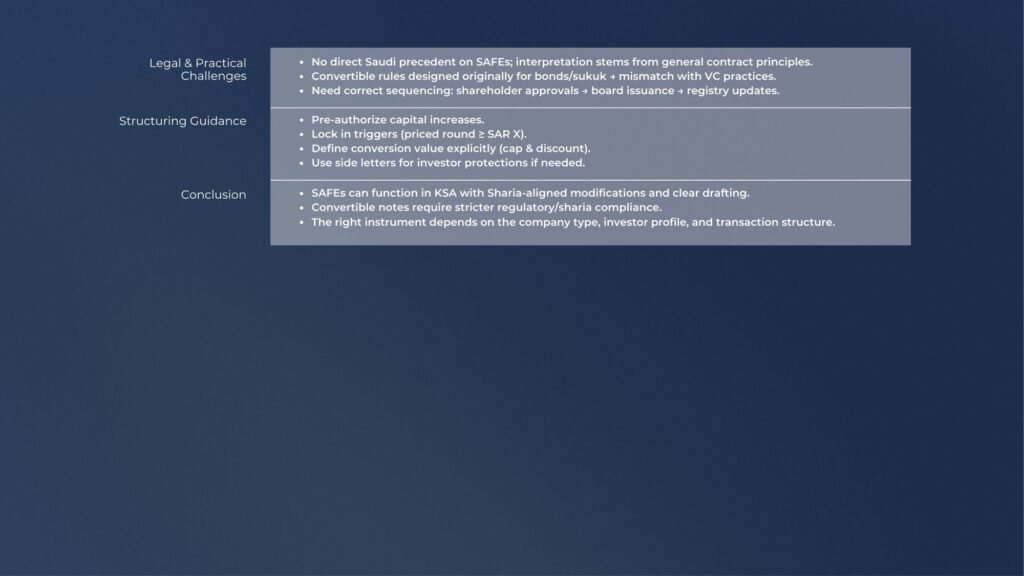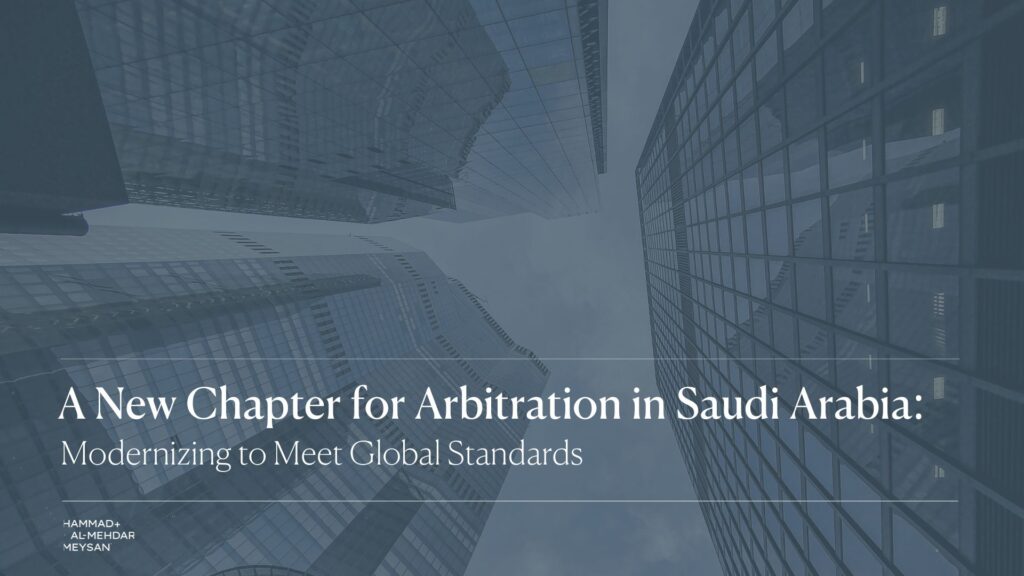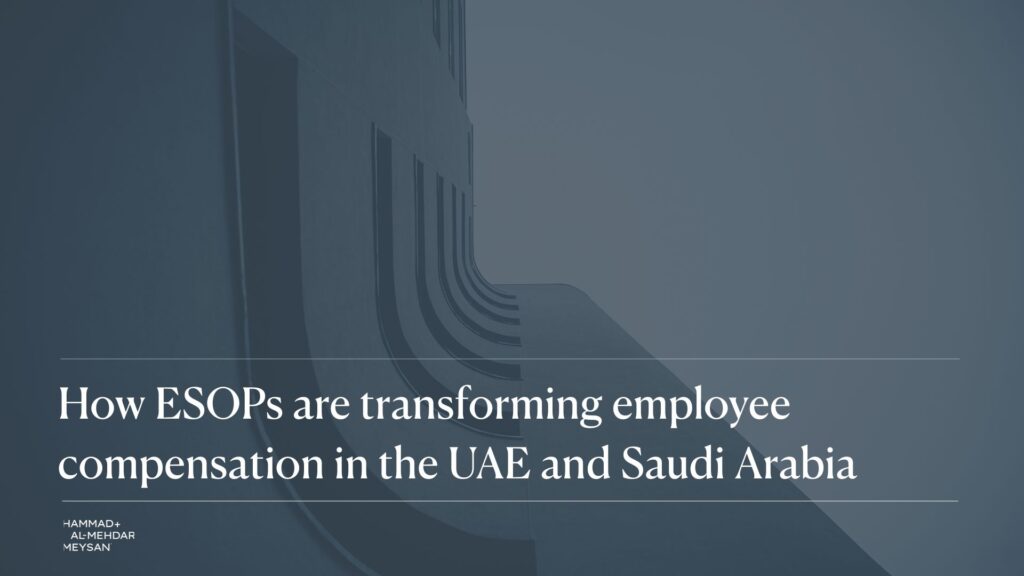



These reforms will:
Once enacted, Saudi Arabia’s new arbitration law is expected to transform the Kingdom into a modern, arbitration-friendly jurisdiction, attractive to international parties while preserving core legal principles. It marks a pivotal step in reinforcing Saudi Arabia’s position as a reliable and competitive forum for dispute resolution in the Middle East and beyond.

Over the past decade, Saudi Arabia has steadily built credibility as an arbitration-friendly jurisdiction. The 2012 law, which drew heavily on the UNCITRAL Model Law, introduced party autonomy and procedural predictability. The creation of the Saudi Center for Commercial Arbitration (“SCCA”) in 2017 further professionalized case administration, and Saudi courts have increasingly demonstrated deference to arbitral awards, including the enforcement of foreign awards under the New York Convention. The new draft law aims to consolidate this progress, remedy residual ambiguities, and bring the legal framework in line with leading arbitral seats worldwide.
A long-standing source of uncertainty under the 2012 regime was the absence of explicit guidance on which law governs the arbitration clause itself. The draft law resolves this by granting parties full freedom to select that governing law; failing such choice, the law of the seat of arbitration will apply by default. This aligns Saudi practice with the UK Arbitration Act (as amended 2024) and similar global reforms, reducing interpretive disputes and increasing predictability. In effect, parties can now determine in advance how issues such as validity, separability, and interpretation of the arbitration clause will be assessed, minimizing procedural surprises.
The proposed law removes outdated constraints on who may act as an arbitrator. The prior requirement that the presiding arbitrator or sole arbitrator hold a Sharia or law degree has been deleted. Under the new regime, any person with full legal capacity and a clean criminal record may serve, regardless of nationality or academic background. This widens the talent pool to include international practitioners and technical experts, a key development for complex commercial or construction disputes.
Equally significant is the introduction of qualified immunity for arbitrators. Except in cases involving bad faith, fraud, or gross negligence, arbitrators will be protected from personal civil liability arising from their decisions. This mirrors international best practice and should encourage seasoned arbitrators to accept Saudi appointments without apprehension of litigation. The draft further confirms the requirement of an odd-numbered tribunal and provides clear, time-bound procedures for challenging or replacing arbitrators, ensuring both independence and efficiency.
For the first time, Saudi arbitration law will expressly recognize joinder of additional parties and consolidation of related proceedings. Where a third party is bound by the same arbitration agreement, it may be joined to the existing arbitration subject to due process safeguards. Similarly, separate arbitrations can be merged into a single proceeding with the consent of all parties. These mechanisms are particularly relevant in construction, infrastructure, and consortium disputes, where interconnected contracts and overlapping parties are common. By adopting these tools, long standard under major institutional rules, the draft law promises greater procedural economy and consistency in outcomes.
The draft law empowers arbitral tribunals to order interim measures, such as asset freezes, evidence preservation, or injunctive relief, and mandates Saudi courts to enforce such measures within 15 days. This closes a major gap in the current regime, where tribunals lacked clear statutory authority to grant enforceable interim orders.
In a further leap, the law expressly recognizes emergency arbitrators, authorizing their orders to have the same binding effect as interim awards. Parties may therefore seek urgent protection before the full tribunal is constituted, with confidence that local courts will give effect to such orders. This alignment with the UNCITRAL Model Law (2006) and leading institutional rules strengthens Saudi Arabia’s reputation as a responsive and reliable arbitral seat.
Reflecting the global move toward technology-driven dispute resolution, the draft law formally endorses electronic communications, digital signatures, and virtual hearings. Notices sent by email or text message will be deemed valid service, and awards may be signed electronically, even if the arbitrators are abroad, while still being considered issued at the Saudi seat.
Tribunals are also empowered to issue partial or interim awards resolving discrete issues before the final decision, an innovation that accelerates resolution in complex cases. Furthermore, the draft law permits virtual hearings, remote witness testimony, and flexible language selection. Arabic remains the default if not agreed otherwise, but parties are free to choose any language for proceedings. Collectively, these provisions ensure that arbitration in Saudi Arabia operates on par with the most modern international practices.
The law also clarifies cost obligations: parties are jointly responsible for arbitral fees, and tribunals may withhold awards pending payment. Courts may compel release of an award once fees are settled, discouraging tactical non-payment.
The annulment process will remain grounded in UNCITRAL principles but with key clarifications. Awards may be set aside if the tribunal disregards the parties’ chosen substantive law or if the award contravenes Sharia or Saudi public policy, now expressly codified. More innovatively, courts may pause annulment proceedings for 60 days to allow the tribunal to correct formal defects, such as missing signatures, without altering the substance. This pragmatic approach preserves awards that would otherwise be invalidated for technical flaws.
Enforcement reforms are equally impactful. Either party may now appeal a court’s enforcement decision, whether granting or refusing enforcement, to the Saudi Supreme Court, ensuring uniform jurisprudence. Enforcement judges may also suspend proceedings for 60 days to permit rectification of technical errors, reinforcing a pro-enforcement stance.
Importantly, the draft affirms that arbitral awards (domestic or foreign) carry res judicata effect, subject only to narrow public-policy exceptions. Combined with the designation of the Commercial Court of Appeal in Riyadh as the primary supervisory authority for international arbitrations, these changes centralize expertise and enhance procedural consistency.
Once enacted, the law will markedly increase the attractiveness of Saudi Arabia as a seat of arbitration. Its convergence with the UNCITRAL Model Law and other modern statutes will simplify cross-border practice, providing familiar procedures and reliable enforcement. Key benefits include:
For foreign investors, these features translate to lower dispute-resolution risk and greater confidence in Saudi enforcement mechanisms.
To take full advantage of the upcoming regime, parties should:
Saudi Arabia’s forthcoming Arbitration Law represents a decisive modernization of its dispute-resolution framework. It blends global best practices with domestic legal values, producing a regime that is efficient, technologically current, and firmly supportive of arbitral autonomy. For businesses operating in or with the Kingdom, the reform signals a more predictable, investor-friendly environment and underscores Saudi Arabia’s ambition under Vision 2030 to serve as a premier regional hub for arbitration.
With these reforms, arbitration in Saudi Arabia is set to become faster, fairer, and more consistent with international expectations, while preserving the integrity of Sharia and national public policy. The result is a balanced and forward-looking system that strengthens confidence among both domestic and international stakeholders that their disputes can be resolved independently, efficiently, and conclusively in the Kingdom.

In practice, the Charter signals that Saudi Arabia is preparing to regulate AI in the same way it regulates financial services, healthcare, data, and critical infrastructure through structured controls, defined accountability, and enforceable expectations. Rather than waiting for global frameworks to mature, the Kingdom is positioning itself as a rule-setter. This means organisations operating here should prepare for a future in which AI systems cannot simply be deployed because they are innovative; they will need to be justified, monitored, and explainable.
This matters because AI is already influencing decisions that affect people’s rights, access, and opportunities. Credit scoring, hiring tools, predictive analytics, automated compliance checks, content moderation, and medical decision-support systems are not theoretical issues; they are real technologies already in use. The Charter anticipates this reality and places responsibility firmly back on humans. It expects organisations to know how their systems work, understand the data used to train them, monitor for bias in outcomes, and retain the ability to intervene.
The Charter also reinforces one of Saudi Arabia’s strongest legal themes data sovereignty. With the Personal Data Protection Law now fully enforced, the Charter supports a future in which AI models trained on Saudi data must comply with Saudi rules. That includes lawful processing, transparency, minimisation, cybersecurity, and restrictions on international data transfers. Many global AI models cannot meet these standards today, meaning companies will need to revisit how datasets are sourced, how cloud infrastructure is structured, and how transparency obligations to regulators and individuals are met. AI built on ambiguous, scraped, or non-compliant data will struggle to find a home under Saudi law.
Commercially, this triggers a second shift: AI contracts will need to evolve. The traditional software-as-a-service template is no longer adequate. Organisations will need clarity on model governance, training data provenance, audit rights, IP ownership, liability limits, and accuracy thresholds. Vendors will be expected to disclose more. Deployers will have to validate more. Boards will need to review more. The Charter implicitly raises the standard of care expected of everyone in the AI supply chain, from developers and integrators to operators and end users.
There is also a strategic dimension. By shaping its own AI governance narrative, Saudi Arabia is sending a signal to investors, foreign companies, and regulators: the Kingdom is not simply adopting AI; it is shaping the environment in which AI can safely and confidently scale. This is essential for sectors such as finance, healthcare, energy, aviation, and smart city development, where the risks of opaque or untested algorithms are high. A clear framework reduces uncertainty and provides confidence to international partners seeking stability in emerging markets.
The Riyadh Charter is laying the foundations for the Kingdom’s future AI law. While the Charter itself is not yet legislation, its principles of accountability, transparency, fairness, human-centric design, and responsible use foreshadow the standards that regulators will enforce. Organisations that begin preparing now will be better positioned to comply and will face fewer operational disruptions as formal regulations are introduced.
For businesses, the direction of travel is unmistakable. AI cannot be an uncontrolled layer added to existing systems. It must be governed with the same seriousness as financial reporting, cybersecurity, and data protection. Senior leaders will soon be expected to demonstrate that their AI systems are safe, explainable, and legally grounded. Those who move early will not only reduce risk but also gain a competitive advantage as AI adoption accelerates across the Kingdom.
The Riyadh Charter ultimately tells a story of ambition aligned with responsibility. It positions Saudi Arabia as a global voice in shaping AI governance. It offers organisations a clear signal: innovation will be supported, but only within a framework that protects people, ensures accountability, and strengthens trust.

One of the most visible impacts of Vision 2030 on professional football is the significant investment in infrastructure. Modern stadiums, training facilities, and youth academies are being constructed to meet international standards, providing skilled players with high-quality environments for training and competition. Infrastructure upgrades also enhance the fan experience, attracting larger audiences and boosting tourism. Economically, these investments stimulate local businesses, generate employment opportunities, and support sustainable growth within the sports sector.
Vision 2030 promotes the professionalisation of football clubs and the Saudi Pro League, requiring clubs to adopt robust governance structures, transparent financial management, and strategic long-term planning. Licensing and compliance frameworks, aligned with national and international standards, are being implemented to ensure accountability and sustainability. By encouraging professional management practices, the initiative increases the commercial appeal of clubs, attracting domestic and international investors and partnerships, while raising the overall competitiveness of Saudi football.
A core objective of Vision 2030 is the development of domestic football talent through structured youth programmes and academies. Investments in coaching education, scouting networks, and training infrastructure enable young athletes to develop skills at a professional level, creating a pipeline of talent for clubs and the national team. By fostering homegrown talent, Saudi football reduces dependence on foreign players while enhancing national pride and the quality of domestic competitions. This focus on talent development also contributes to job creation and human capital growth in the sports sector.
Under Vision 2030, professional football is positioned as an engine of economic growth. Revenue streams such as broadcasting rights, sponsorship deals, merchandise sales, and ticketing are being expanded and formalised. Strategic partnerships with international leagues and clubs enhance brand visibility and attract global attention, creating new business opportunities. Clubs are increasingly operating as professional enterprises, leveraging football’s popularity to generate sustainable revenue and contribute to the Kingdom’s broader economic diversification goals.
Vision 2030 emphasises elevating Saudi football onto the international stage, both through club competitions and national team success. Initiatives include hosting international tournaments, attracting high-profile foreign players and coaches, and engaging in international collaborations to improve standards and operational expertise. Enhanced competitiveness raises Saudi football’s global profile, positioning the Kingdom as a destination for talent, investment, and major sporting events, while strengthening diplomatic and cultural ties through sport.
Beyond economic and competitive outcomes, Vision 2030 recognises football as a tool for social development and community engagement. Football promotes health, teamwork, and national identity, while encouraging participation across all demographics. Initiatives to increase women’s participation in football, support grassroots programmes, and promote inclusivity are integral to Vision 2030’s broader objectives. By connecting communities through sport, professional football becomes a medium for fostering social cohesion, cultural awareness, and national pride.
Saudi Vision 2030 has fundamentally reshaped professional football in the Kingdom, driving infrastructure development, club professionalisation, talent cultivation, economic growth, and social engagement. By aligning football development with strategic national objectives, the initiative enhances both the sporting and commercial value of the game, while positioning Saudi Arabia as a leading hub for professional football in the region. The continued implementation of Vision 2030 promises sustained growth, international recognition, and long-term benefits for athletes, clubs, fans, and the broader society.

Saudi Arabia’s professional football clubs are required to comply with licensing regulations issued by the Saudi Football Federation (SFF) in line with international best practices. These licences cover multiple dimensions, including financial management, governance structures, infrastructure standards, youth development programmes, and legal compliance. Licensing ensures that clubs operate sustainably, meet contractual obligations to players and sponsors, and maintain the integrity of competitions. Economically, the framework incentivises investment in club facilities, professional staff, and youth academies, which ultimately enhances the market value of the league and the broader football ecosystem.
Licensing dynamics have profound economic implications for both clubs and the national football industry. Financially sound clubs attract domestic and international investors, creating opportunities for long-term partnerships and sponsorship agreements. Compliance with financial licensing requirements also mitigates the risk of insolvency, ensuring that clubs can fulfil contractual obligations to players, staff, and partners. Economically, a stable, well-regulated league increases the attractiveness of broadcasting rights, merchandise sales, and international fixtures, which together stimulate local businesses and tourism. Licensing, therefore, not only ensures regulatory compliance but also strengthens the commercial viability of professional football in Saudi Arabia.
Player licensing and registration play a critical role in regulating the movement, eligibility, and compensation of athletes. Licensing ensures that player contracts adhere to national and international standards, covering issues such as salary structures, transfer fees, and dispute resolution mechanisms. From an economic standpoint, regulated player markets contribute to competitive balance between clubs, protect clubs from unsustainable wage inflation, and promote talent development by encouraging investment in training and youth academies. Properly managed player licensing supports a predictable, transparent market that benefits both clubs and players while enhancing the Saudi professional league’s international reputation.
Licensing requirements for clubs extend beyond finances and governance to include infrastructure standards. Stadium facilities, training grounds, and medical facilities must meet specified criteria to ensure safety, spectator comfort, and player professional development. Economically, infrastructure investments generate employment opportunities, enhance fan engagement, and create avenues for ancillary revenue streams, such as event hosting and sponsorship activations. By enforcing infrastructure standards, licensing contributes to a high-quality football experience and supports the broader economic impact of the sport.
Looking ahead, the licensing system is expected to evolve in response to increasing commercialisation, international partnerships, and the growing popularity of football as both a spectator and investment asset. Clubs that proactively adhere to licensing requirements are better positioned to attract global investors, enter international competitions, and leverage commercial opportunities. Economically, this strengthens the overall market for professional football in Saudi Arabia, encourages regional competitiveness, and reinforces the sector’s contribution to national development objectives under Vision 2030.
Licensing dynamics in Saudi professional football represent more than a regulatory requirement; they are a critical economic mechanism that underpins club stability, market transparency, and sustainable growth. By ensuring compliance across financial, operational, and player-related dimensions, the licensing framework enhances both the commercial and social value of football in the Kingdom. Clubs and stakeholders that strategically engage with licensing requirements can capitalise on the sport’s economic potential, securing long-term success for professional football and contributing to the broader sports economy in Saudi Arabia.

At the heart of the new regulatory landscape is a shift in responsibility. The Ministry and the Sports Federations expect private sports clubs to operate as fully accountable institutions: compliant, well governed, financially transparent, and professionally managed. This means the era of informal structures and loosely defined operating models is over. Clubs are now expected to demonstrate that they can safeguard athletes, protect personal data, maintain safe facilities, employ qualified staff, and deliver programmes aligned with national sports standards. Failure to do so is no longer a matter of customer dissatisfaction. It is a regulatory breach.
One of the most significant legal implications lies in licensing and ongoing supervision. The days of a one-off approval are behind us. Under the new regulations, licences are tied to continuous compliance, meaning clubs must maintain audited financial records, document health and safety protocols, ensure equipment standards are met, and adopt a clear governance structure. This includes defined roles for managers, technical leads, compliance officers, and risk supervisors. Regulators now expect clubs to think like professional service providers, not recreational venues.
The protection of athletes, especially minors, sits at the core of the new regime. Clubs must now meet strict requirements on staff vetting, incident reporting, safeguarding policies, and training for coaches who work with children. These are not optional enhancements; they are legal obligations designed to reduce risk and create a safe, structured environment. This shift brings Saudi Arabia in line with international sports governance standards, and it places significant accountability on club owners who can now face penalties for failing to implement appropriate safeguards. The message is clear: the physical, emotional, and psychological safety of athletes is a regulated duty.
Data protection is another area of profound impact. Sports clubs hold sensitive information including biometric data, medical records, performance analytics, CCTV footage, and children’s personal data. The Personal Data Protection Law (PDPL) applies in full, meaning clubs must obtain proper consent, justify every category of processed data, implement secure systems, and restrict cross border transfers. Many clubs will need to redesign their membership systems, upgrade their digital platforms, and ensure that their wearable technology or performance tracking tools comply with PDPL. AI enabled analysis and tracking, increasingly common in modern training environments, will require even stricter controls.
Commercially, the regulations transform how clubs’ contract with suppliers, coaches, and partners. Employment relationships must be formalised with clear contractual obligations around qualifications, training methods, professional conduct, and liability. Outsourcing arrangements for cleaning, security, maintenance, or third party trainers must include compliance clauses, insurance requirements, and defined accountability. Sponsorship and brand partnership agreements will now be scrutinised for advertising standards, athlete image rights, and alignment with regulatory codes. For many operators, this will mean updating legacy contracts that are no longer fit for purpose in a regulated environment.
Financial integrity sits at the centre of the new framework. Clubs must maintain accurate books, avoid commingling funds, and ensure proper fee structures. Refund policies, membership terms, and package structures must be transparent and fair. Regulators are paying increasing attention to misleading advertising, unfulfilled training programmes, and unauthorised hidden charges. For investors and new entrants, this clarity is welcome. It reduces risk and introduces a governance baseline that supports long term growth. For existing clubs, it requires a fundamental shift in how operations are documented, priced, and disclosed.
There is also a wider strategic dimension. Saudi Arabia’s sports sector is rapidly professionalising, and the new regulations are creating the foundations for a market capable of attracting international operators, franchised fitness brands, and private capital. Clear rules offer confidence. They define how a club should be run, what investors can expect, and how disputes will be resolved. The implications are far reaching, from real estate planning and licensing costs to workforce requirements and compliance documentation. Those who adapt early will be best positioned to secure partnerships, access government programmes, and expand across the Kingdom’s growing sports hubs.
Ultimately, the new regulatory framework tells a clear story. Saudi Arabia is no longer building a sports industry based on aspiration alone. It is building one on governance, accountability, and global standards. Private sports clubs are transitioning from community amenities to regulated institutions with legal duties and enforceable responsibilities. The operators who recognise this shift and align their structures, contracts, data practices, and workforce models accordingly will not only comply with the law but also gain a competitive advantage in a market that is becoming more sophisticated by the day.

Learn how market trends and legislative changes are changing employee compensation in the UAE and KSA, encouraging startups to adopt equity-based rewards.
This article was co-created by HMCo team and Carta.
For MENA’s growing startup ecosystem, equity is shifting from a nice-to-have to a key part of competitive compensation. Founders increasingly see employee ownership as a way to attract top talent, improve retention, and align teams with long-term company growth.
Despite this momentum, many companies still find it challenging to craft a well-structured employee share ownership plan (ESOP) to incentivise employees. With so many moving parts to consider, from navigating implementation rules to designing the right vesting schedules, it can be difficult for founders if they don’t get it right the first time.
Carta works with thousands of global founders and understands the complexities involved in designing the right ESOP for their team. That’s why we partnered with HMCo to outline the legal, operational, and cultural considerations for ESOPs to help founders reshape their employees’ ownership journeys in the United Arab Emirates (UAE) and Kingdom of Saudi Arabia (KSA).
An ESOP is a long-term incentive plan (LTIP) that grants employees the right to buy shares at a predetermined strike price at a time in the future, subject to vesting. Typically, new shares are issued when the options are exercised.
When designed well, an ESOP can be a powerful tool for startups to build a culture of ownership. By giving employees a chance to own a portion of the company, you’re turning them into owners. This aligns the interests of employees with those of the company, which is an effective method to attract, motivate, and retain top talent. When you link rewards to the company’s long-term performance, ESOPs can foster sustained commitment and contribution to overall company growth.
ESOPs typically include vesting structures which vary based on a company’s needs and may include:
Many companies start with a cliff period followed by a graded or ratable vesting schedule.

When designing ESOPs, companies must also consider various liquidity and exit strategies to help navigate key moments.
Key best practices include:
Companies should also consider the accounting impact of creating ESOPs, because these plans create an obligation to issue stock at a discount or pay employees in cash. Both items may require recording in the companies’ books as liabilities.
United Arab Emirates
The UAE’s legal system has multiple jurisdictions, so where you’re incorporated matters when you want to issue ESOPs.
Key jurisdictions include:
In onshore UAE, non-UAE nationals may face restrictions on holding shares in certain sectors. This is where options like phantom share schemes, where an entity holds the shares on behalf of the employee, can be used as alternatives.
Free zone companies may also need to comply with employment and securities laws relevant to their jurisdiction.
In KSA, the key to issuing ESOPs is getting approval from your shareholders.
Board approval may also be required, depending on your company’s bylaws or articles of association.
The good news is that ESOPs are generally considered an exempted offer and do not trigger filing requirements. This designation allows employers to issue unlisted, contract-based securities to employees without being subject to the full scope of applicable Capital Market Authority (CMA) regulations.
That said, the CMA does impose specific disclosures. These include quarterly notifications to the CMA detailing the total number and value of the exempted offers and reporting on any ongoing ESOP offers.

Carta data shows that 67% of grants in Middle East (ME) startups follow a four-year vesting schedule with a one-year cliff, signaling that startups in the region are consistent in their equity vesting practices. The regional norm for structure is 25% of equity vests after the first year and the remaining 75% vests monthly thereafter.
This growing culture of ownership in the MENA region shows a fundamental shift in how companies approach talent and growth. If founders understand the process of designing a well-structured ESOP, they can not only attract and retain top talent, but also build a culture of shared success.
In MENA, where equity has become a must-have, sharing ownership is the new engine for growth.
DISCLOSURE: This communication is on behalf of eShares, Inc. dba Carta, Inc. (“Carta”) and HMCo. This communication is for informational purposes only, and contains general information only. Carta and HMCo are not, by means of this communication, rendering accounting, business, financial, investment, legal, tax, or other professional advice or services. This publication is not a substitute for such professional advice or services nor should it be used as a basis for any decision or action that may affect your business or interests. Before making any decision or taking any action that may affect your business or interests, you should consult a qualified professional advisor. This communication is not intended as a recommendation, offer or solicitation for the purchase or sale of any security. Carta and HMCo do not assume any liability for reliance on the information provided herein.
© 2025 Carta. All rights reserved. Reproduction prohibited. Regulated by the Financial Services Regulatory Authority.
The contents of this article may contain attorney advertising under the laws of various jurisdictions. Prior results do not guarantee a similar outcome. By receiving this communication you understand and agree that no information is being provided in the context of any attorney-client relationship and that nothing herein is intended to constitute legal advice. This communication is solely informational in nature, not intended as a substitute for competent legal advice from a licensed and retained attorney in your jurisdiction, and should not be so used.